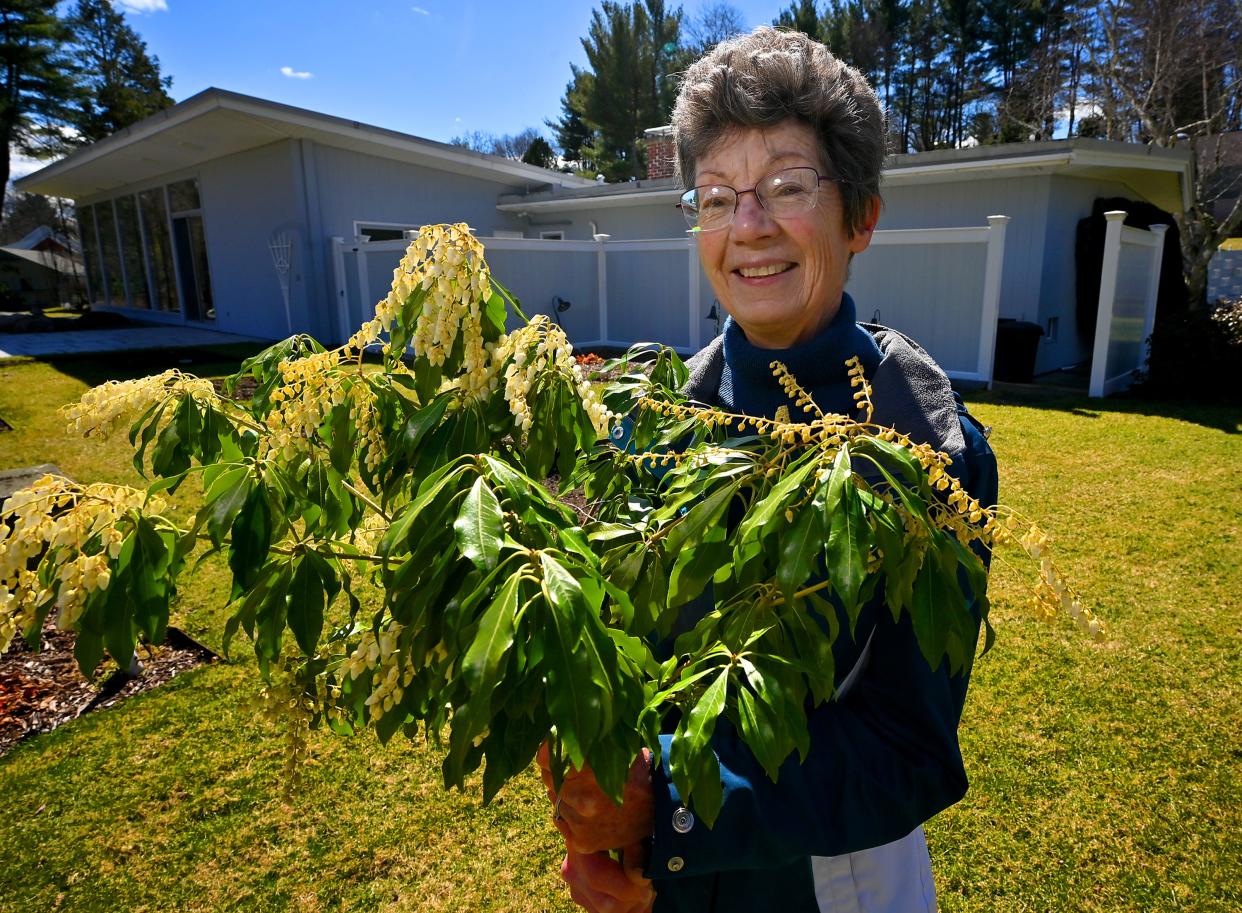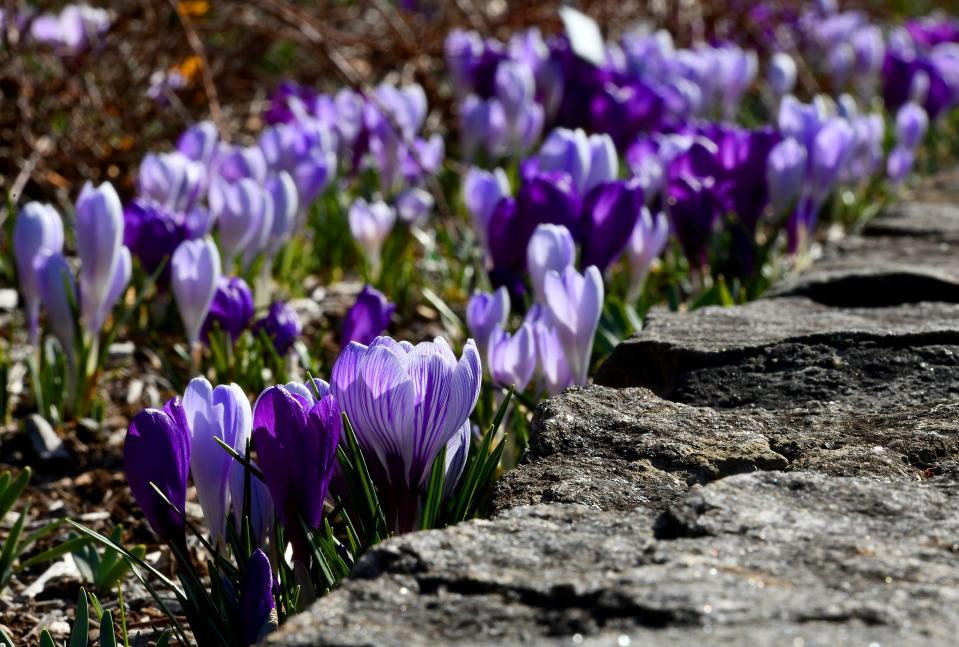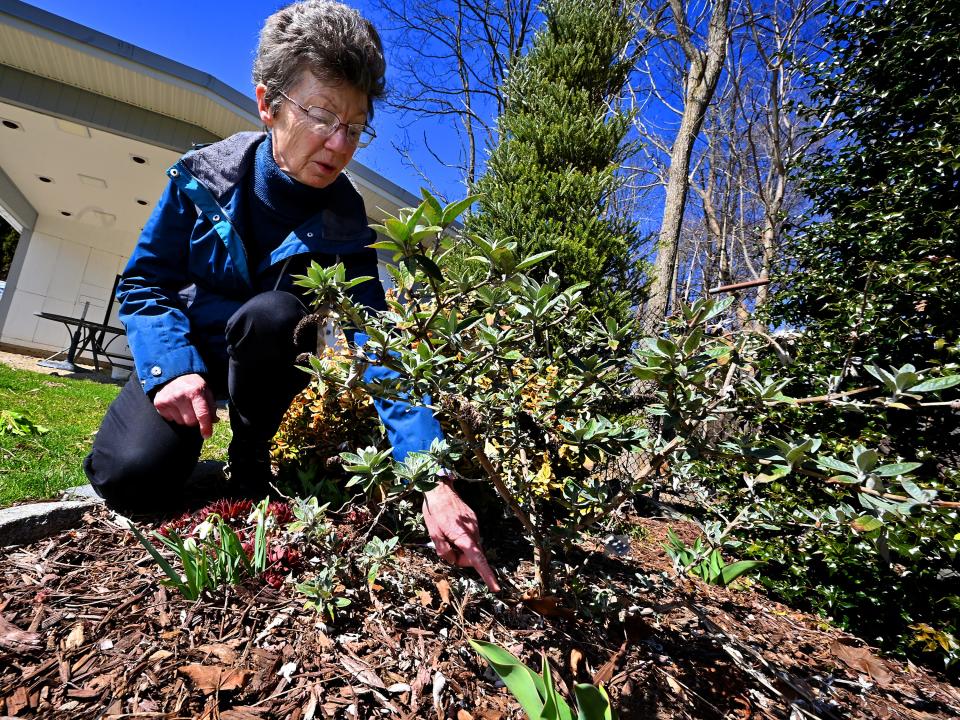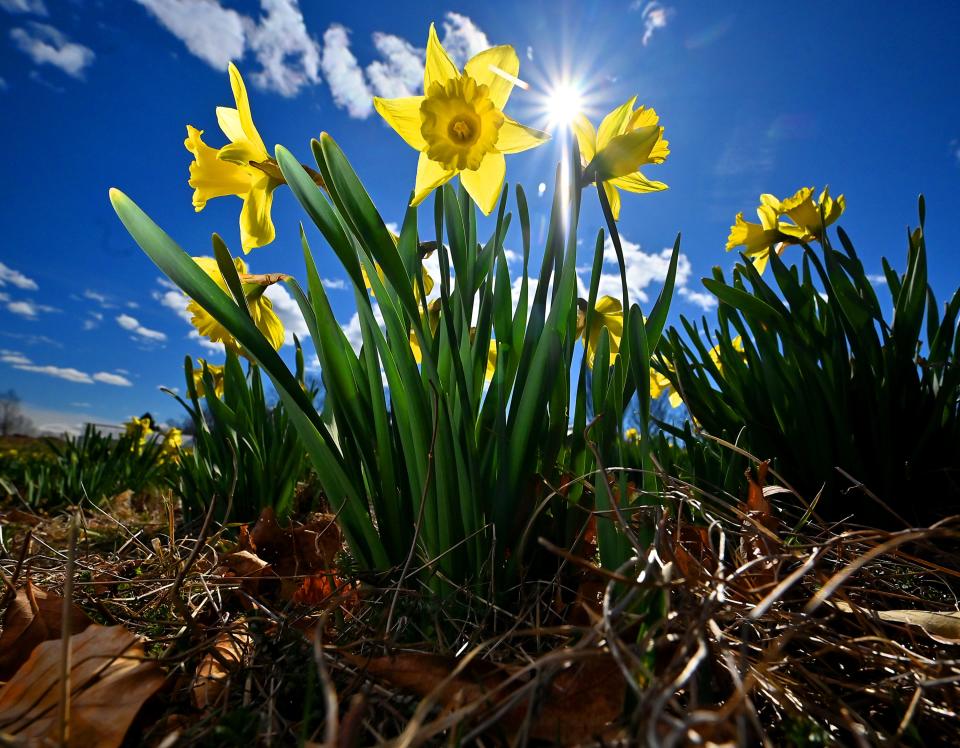First day of spring after a warm winter in Worcester: The daffodils couldn't wait

WORCESTER — Tuesday marks the official start of spring, as the vernal equinox kicks in at 11:06 p.m. Eastern Daylight Time. Have you noticed that many plants are budding and flowering earlier than normal this time of year?
Donna Rose has.
The Worcester resident manages her impressive home garden on Meadowbrook Road, a labor of love for nearly 40 years. Many of her plants are budding a few weeks to a month early.
“It’s very early,” Rose said of her hyacinth that displays small, green buds. Her daffodils are also budding and the abelia shrub retained its leaves through the winter, which is unusual. Meanwhile, a nearby P.J.M. rhododendron bush has pink flowers that are starting to peak out of tight buds.
“It’s quite early,” she said of the pink inside those buds that look like they might fully flower any day now.
With the last name of Rose, of course there are roses on the property. Their stalks are standing tall, a strange sight because they normally shrink to the ground in winter.
“They’re all living,” Rose said of her statuesque "Pink Bountiful" rose stalks. “Look at the new leaves. They’re popping out. It’s amazing.”
More: When does spring start? Here's what to expect from the vernal equinox

There's no doubt that winters are warmer in Worcester. This year's meteorological winter, from Dec. 1 through Feb. 29, recorded an average mean temperature of 33.5 degrees Fahrenheit. It was the second-warmest in Worcester's history, trailing only last year's meteorological winter of 33.7 degrees. Before last winter, the prior record was 33.1 degrees, during the winter of 2001-2002.
Milder winters in Worcester have resulted in virtually no snow cover to keep the ground cold and hold plants in their hibernation mode. Since the ground is warmer, plants grow and it's happening earlier. That’s how Rose, a member of the Worcester Garden Club and an official “Master Gardener” — one has to complete intensive horticultural training to achieve that designation — sees the premature growth.
She stressed it’s only her theory, that she’s not a climate scientist. She also noted the warming of the oceans and changing weather patterns are contributing to warmer springs and early blooms.
It's climate change, no doubt, says specialist
Climate change is “100% ” behind the phenomenon of warmer springs and earlier blooms, said Rebecca Quiñones, a climate change specialist at the state Division of Fisheries and Wildlife.
At her Shrewsbury home, Quiñones has daffodils budding several weeks earlier than what she observed from the same plants when she moved into her home seven years ago. "The shift has been pretty dramatic," she said.
Change isn’t confined to plants.
Quiñones hears a steady hum from frogs in nearby wetlands and vernal pools, sounds emanating a few weeks earlier than customary. She has also seen some bird species including a wood duck and red-winged blackbird flying into the area, sights that generally don’t happen this early in spring.
Quiñones and her professional colleagues access records stored at Boston University that detail plant budding and bird migration schedules in parts of Massachusetts that go back more than 100 years. She said there’s no question, when comparing that data to today, that plants are blooming sooner and some birds are arriving weeks before they're expected.
The warming planet, she said, is the driving force behind the changes.

BU professor couldn't agree more
Richard Primack agrees.
A biology professor at Boston University, Primack said warmer spring seasons are caused by increased amounts of carbon dioxide released into the atmosphere. More carbon in the air means a hotter planet, said Primack, and the chemical is coming from the burning of fossil fuels like oil, coal and natural gas.
In addition, the chopping down and burning of rain forests in Brazil, Indonesia and Central Africa release more carbon into the air, said Primack.
He noted a comparison to highlight what is behind a hotter planet — before the industrial revolution, 270 parts per million of carbon dioxide entered the atmosphere. Since industrialization, the number jumped to 420 parts per million and it’s increasing 2 parts per million annually.
Last week, Primack’s field work took him to the historic Massachusetts town of Concord, where he saw blewit mushrooms growing in Sleepy Hollow Cemetery and marsh marigolds flowering between Walden Pond and the Sudbury River. Those sightings are earlier when compared to prior years, said Primack.
“We will continue to have warming effects on plants and animals in the U.S. and Massachusetts in the coming decades,” said Primack. “Despite conservation measures like solar panels, electrification of cars and wind power, carbon in the atmosphere is increasing.
“The world will get warmer, and without conservation measures, it would have been worse. The good things we’re doing are not enough.”

Nothing out of the ordinary
Mark Richardson, horticulture director at the New England Botanic Garden at Tower Hill, doesn’t dispute that some plants are showing their buds early, even flowering. But this spring isn’t out of the ordinary because it’s part of a warming trend that goes back several decades.
“A lot of trends to earlier blooms have been going on for a long time. This year does not stick out as an anomaly, for me, at least,” said Richardson.
When plants bloom early, there is an advantage, said Richardson, because we're starving for something to give us an emotional lift after a long winter. At Tower Hill, a large field of daffodils are raising spirits and so are Virginia bluebells appearing in Richardson’s home garden in Uxbridge.
“We’re desperate for color. We all need it right now. It’s the end of winter and we’re looking forward to spring," he said.

Downsides to an early bloom
There are potential negatives to an early spring, said Richardson. If a plant blooms prematurely, it could be susceptible to damage if there’s a subsequent deep freeze. That happened last year in February when a subzero front rolled into Worcester. Weeping cherry trees that leafed out early saw their buds harmed.
Richardson worries there could be a repeat of last year’s destruction if there’s another late frost.
There’s another matter raised by Richardson — harsh weather can be a problem for some plants and trees that bear fruit. The fruit includes seeds and it's important for the seeds to germinate so the next generation of that species can live.
If, for example, a frost kills the early buds on weeping cherry trees, then fewer seeds are produced and the next generation of the tree may not survive. Besides, foraging wildlife depend on the seeds as a food source and pollinators need the plants to continue in order to support the food chain.
Olympic gymnast
Rose approached a narrow tributary that runs through her backyard and displayed the balance of an Olympic gymnast as she stepped across slippery rocks to the other side of her property. Once there, she snapped off a branch on a large andromeda bush and deftly navigated the rocks while holding the branch on her return. All of it was done to show off the branch's flowers that normally bloom in April.
Two more plants concluded Rose's garden tour. A redbud tree had tiny black buds visible on its bark. “It’s the only tree to push flowers out from its branches, through its bark,” said Rose.
The final stop was a skimmia Japonica that Rose described as a type of evergreen bush.
“It’s close to flowering,” she said. “It normally blooms in mid-April. It’s a month ahead.”
Contact Henry Schwan at henry.schwan@telegram.com. Follow him on Twitter @henrytelegram
This article originally appeared on Telegram & Gazette: First day of spring after warm winter in Worcester

